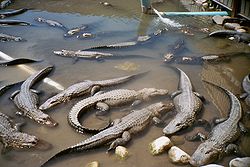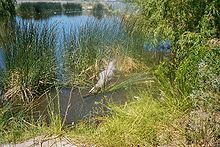- Colorado Gators Reptile Park
-
Colorado Gators Reptile Park 
Alligators at the Colorado Gators Reptile ParkDate opened 1990[1] Location Mosca, Colorado Land area 80 acres (32 ha)[1] Coordinates 37°42′21″N 105°52′14″W / 37.705893°N 105.870556°WCoordinates: 37°42′21″N 105°52′14″W / 37.705893°N 105.870556°W Website http://www.gatorfarm.com/ Colorado Gators Reptile Park was opened to the public in 1990, in Mosca, Colorado, United States. Located 17 miles (27 km) north of Alamosa, Colorado, it started as a tilapia farm in 1977, and now includes a bird sanctuary, reptile rescue, education, and display, and a biodome.[2]
A geothermal well on the property creates ponds and wetlands for the alligators, but also provides habitat and food for many water-birds and waterfowl. The "Two Mile Creek Wildlife Habitat" lets visitors view alligators, reptiles, and birds in a natural setting, and to go fishing, boating, and picnicking.[3] Over 125 species of birds have been sighted at the farm.[4]
Contents
History
In 1977, Erwin and Lynne Young purchased 80 acres (32 ha) on which they started a farm to grow tilapia and African perch. The farm includes a geothermal well that is used to keep the water at a temperature appropriate for the fish. In 1987, they purchased 100 1-year old alligators to help dispose of fish-processing waste. The alligators grew, and locals wanted to see them, so the farm was opened to the public in 1990.[1]
Over the years, the farm has also become home to many reptiles that are unwanted, abused, and sometimes dangerous, when people discover that they can no longer care for them. One of the goals of the farm is to help educate the public as to the challenges and dangers of trying to keep reptiles as pets.[5]
Events
The farm holds "Gatorfest" on the first weekend in August each year. This is world's first Gator Rodeo and Roundup, and includes roping, riding, and barrel racing.[3]
Education
Education programs created by the Colorado Gators Reptile Park aim to teach people about the biology, behavior, and ecological role of reptiles, as well as which reptiles make good pets and which will eventually get big enough to become impossible to handle. The programs include live specimens such as turtles, tortoises, alligators, snakes, and lizards, some of which the audience is allowed to touch.[6]
Notes
- ^ a b c "Meet the Family". gatorfarm.com. Colorado Gators Reptile Park. http://www.gatorfarm.com/Meet_the_Family.html. Retrieved 27 March 2010.
- ^ "Colorado Gators Reptile Park". gatorfarm.com. Colorado Gators Reptile Park. http://www.gatorfarm.com/. Retrieved 13 March 2010.
- ^ a b "Colorado Gator & Reptile Park". coloradodirectory.com. The Colorado Vacation Directory. http://www.coloradodirectory.com/coloradogatorpark/. Retrieved 27 March 2010.
- ^ "Birds". gatorfarm.com. Colorado Gators Reptile Park. http://www.gatorfarm.com/birds.html. Retrieved 27 March 2010.
- ^ "Reptile Rescue". gatorfarm.com. Colorado Gators Reptile Park. http://www.gatorfarm.com/Reptile_Rescue.html. Retrieved 27 March 2010.
- ^ "School Programs". gatorfarm.com. Colorado Gators Reptile Park. http://www.gatorfarm.com/School_Programs.html. Retrieved 27 March 2010.
External links
Zoos and Aquariums of Colorado Aquariums Zoos - Butterfly Pavilion
- Cheyenne Mountain Zoo
- Colorado Gators Reptile Park
- Denver Zoo
- Nature and Raptor Center of Pueblo
- Pueblo Zoo
- The Wild Animal Sanctuary
Zoos, aquariums, and aviaries Types of zoos Conservation Lists Animals Other topics - Animals in captivity
- Animal training
- Behavioral enrichment
- Captive breeding
- Frozen zoo
- Immersion exhibit
- Nocturnal house
- Wildlife conservation
- Zookeeper
- Zoology
- Portal
- Project
- Category
- Commons
Categories:- Zoos in Colorado
- Visitor attractions in Alamosa County, Colorado
- Buildings and structures in Alamosa County, Colorado
Wikimedia Foundation. 2010.

